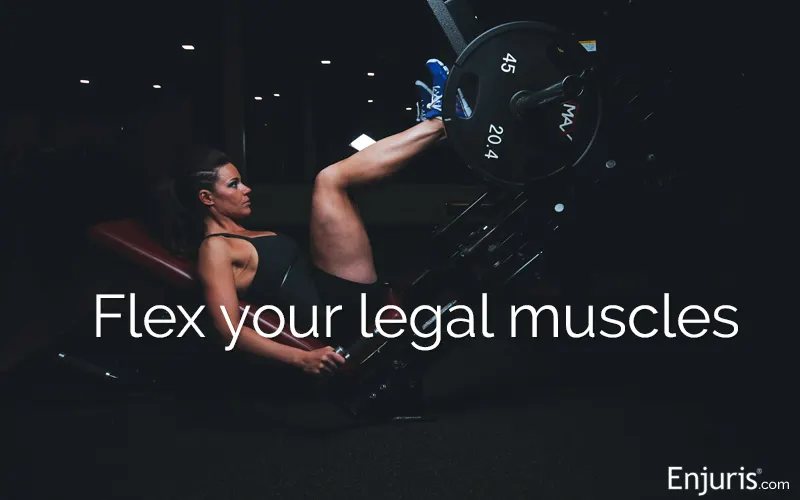
At Enjuris, we would never want to discourage anyone from enjoying the benefits of regular physical exercise.
That said, if you find yourself searching for an excuse to skip a gym day, consider this: one in four people report suffering an injury at the gym in their lifetime, and the path to holding a gym accountable is anything but straightforward.
Most common causes of injuries sustained at fitness facilities
It is widely accepted that physical activity can improve your brain health, help manage weight, reduce the risk of disease, strengthen your muscles, and improve your ability to handle everyday activities. Unfortunately, however, with all forms of physical activity, there is a risk of injury.
According to the National Institutes of Health, some of the most common gym-related injuries include:
- Sprains and strains
- Knee injuries
- Swollen muscles
- Achilles tendon injuries
- Pain along the shin bone
- Rotator cuff injuries
- Fractures
- Dislocations
Though less common, more severe injuries can also occur, including traumatic brain injuries, spinal cord injuries, and even death.
In a tragic incident at the Paradise Bali gym, popular fitness influencer Justyn Vicky, aged 33, suffered a fatal injury after a barbell weight of over 450 pounds fell on his neck while performing squat presses under the supervision of a spotter.
The accident caused a severe neck fracture and compression of vital nerves, leading to Vicky’s death shortly after undergoing emergency surgery.
Known for his significant online following and contributions as a bodybuilder and nutrition coach, Vicky was celebrated for his motivational spirit.
A video of the incident is circulating online.
A number of reports have looked at the most common injuries sustained while working out, but less attention has been paid to the actual causes of these injuries.
One study published in the Journal of Injury Epidemiology examined the most common causes of gym-related injuries. The list includes:
- Tripping and falling on non-motorized equipment
- Tripping and falling on motorized equipment (e.g., treadmills)
- Tripping and falling unrelated to equipment use
- Tripping and falling in changing rooms
- Awkward landings or twists during exercises
- Body parts getting caught in machinery (e.g., fingers in treadmill belts)
- Dropping heavy weights on oneself
- Crushing injuries from heavy weights or objects
- Collisions with other gym-goers
- Collisions with walls or equipment
- Being crushed beneath equipment
- Equipment malfunctioning
- Injuries while moving equipment
- Overexertion injuries
- Assault-related injuries
- Injuries from foreign substances (e.g., rust entering the eye)
- Allergic reactions
Legal options to sue a gym
Whether you can take legal action against a gym depends on the circumstances surrounding your injury, but in many cases, you may have legitimate grounds to file a lawsuit. The two most common causes of action in such situations are based on negligence and product liability.
Let’s take a closer look at each of these causes of action.
Understanding negligence claims against gyms
Negligence in a legal context means a gym didn't meet the expected safety standards that a reasonable entity would under similar situations. To hold a gym liable for negligence, three key elements must be proven:
- The owner of the gym had a duty to protect you from harm,
- The owner of the gym breached their duty to protect you from harm, and
- You were injured as a direct result of the breach.
But how do you know if a gym owner has a duty to protect you from harm? And if the owner does have a duty, do they have to protect you from all harm?
The specific obligations of the gym owner depend on your classification, which is determined by the reason you were on the property. As a gym user, you’re classified as an invitee, which means the gym owes you the highest level of care. This includes finding and fixing any dangerous conditions, or at least warning about them.
So, if you're injured because the gym didn't address a hazard it knew about or should have known about, you probably have a strong negligence case.
Consider the following hypothetical:
Kirra, a regular member of ABC Fitness Center, attends workout sessions three times a week. One evening, while using a treadmill, she slips and falls, resulting in a severe ankle injury.
Upon investigation, it’s revealed that the treadmill had a known issue with a loose running belt, which the gym staff had documented but failed to repair or place a warning sign about.
The gym had a duty to maintain their equipment safely and to warn members of any known hazards. By failing to fix the treadmill or inform gym-goers of the risk, the gym breached its duty of care. Kirra’s injury was a direct result of this negligence. Given these circumstances, Kirra has strong grounds to pursue a negligence claim against ABC Fitness Center.
Understanding product liability claims against gyms
Product liability lawsuits arise from injuries caused by defective or unsafe gym equipment.
Legally, there are three recognized types of defects that can form the basis of a product liability claim:
| Type | Definition | Example |
|---|---|---|
| Manufacturing defect | A defectively manufactured product is one that—though properly designed—left the manufacturer in a condition other than intended. | A set of resistance bands, designed to withstand certain levels of tension, was incorrectly made with substandard rubber. This error caused the bands to snap under normal use, leading to injuries for users performing resistance exercises. |
| Design defect | A product is defectively designed if it failed to perform as safely as a reasonable person would expect, even when used as intended (or at least in a manner that was reasonably foreseeable) | A weightlifting bench was designed with a locking mechanism that was too weak to hold significant weights. Despite being used as intended, the bench collapsed under the weight, causing severe injuries to users during bench press exercises. |
| Failure to warn | Manufacturers have a duty to warn users of the dangers that can be reasonably anticipated and that are inherent in their products. | A batch of dumbbells was intended to have solid metal handles securely welded to the weights. However, due to a manufacturing error, the handles on several dumbbells were not properly welded and detached during use, leading to injuries for users lifting the weights. |
The role of waivers in gym injury lawsuits
When you sign up for a gym membership, one of the first things you will be asked to do is sign a waiver.
A waiver is simply an agreement where you release certain parties (usually the owner of the gym) from any liability related to injuries suffered.
Every state treats waivers differently. In some states, waivers are unenforceable, while in others, they are upheld if they meet specific requirements. Understanding the specifics of the waiver you signed and its enforceability in your state is crucial in assessing the viability of your case.
Common defenses in gym injury cases
In defending against injury claims, gyms may use several defense strategies to limit their liability. Here are some of the most common defenses they might employ:
- Assumption of risk: If a gym-goer voluntarily and knowingly assumes the risk of engaging in potentially dangerous activities at the gym, the gym may not be held liable for any resulting injuries. For example, when a member participates in a high-impact fitness class and has signed an agreement acknowledging the risks involved, this might be considered an express assumption of risk.
- Open and obvious dangers: Gyms might also argue that they are not at fault because the dangerous condition was open and obvious, meaning that the injured party should have noticed and avoided it. While the presence of an open and obvious danger doesn't completely absolve the gym of the duty to maintain a safe environment, it can impact the determination of liability. Courts will consider whether a reasonable person would have avoided the hazard and whether the gym should have taken steps to mitigate an obvious risk.
- Comparative fault: Under the principle of comparative fault, which is recognized in many states in varying forms, an injured party's compensation can be reduced by their percentage of fault. For instance, if a gym member is found to be 30% responsible for their injury because they misused equipment or ignored safety instructions, their awarded damages would be reduced accordingly. In states following a modified comparative fault rule, if the plaintiff is found to be equally or more at fault (usually 50% or more), they may not be eligible to recover any damages at all.
Steps to take after a gym injury
If you're injured at a gym, taking the right steps can significantly impact your ability to pursue a lawsuit.
- Seek medical attention: Your health is the top priority. Prompt medical treatment also provides documentation of your injuries.
- Report the injury: Notify gym management of the incident as soon as possible, ensuring it's documented.
- Document everything: Take photos of the scene and your injuries, and gather contact information from any witnesses.
- Consult a personal injury lawyer: An experienced attorney can evaluate your case, help navigate the complexities of gym injury lawsuits, and advise on the best course of action.

Damages worksheet to track expenses for your injury claim (medical treatment, property damage, lost wages, prescriptions)
Download in PDF format

Sample accident journal/diary to help you document the effect on your daily life
Download in PDF format

A worksheet to prepare for your first meeting with a personal injury attorney – what to bring, what they'll ask
Download in PDF format
Gym injury lawsuits: frequently asked questions (FAQs)
Still have questions about gym-related lawsuits? Let’s see if we can help:
Yes, if the personal trainer acted negligently, such as by recommending inappropriate exercises or failing to provide adequate instruction, you may have grounds for a lawsuit. The gym might also be vicariously liable if the trainer is an employee.
If another gym member's actions led to your injury, you might be able to sue the individual for negligence. However, proving this can be complicated, and the gym may only be liable in certain circumstances, such as if they failed to intervene in unsafe behaviors.
While no laws specifically protect gyms from lawsuits, many states have regulations that affect the enforceability of liability waivers. Additionally, some states have enacted laws related to inherent risks in certain activities, which could apply to gym activities.
Accepting payment does not necessarily waive your right to sue, but it can complicate matters. Always consult a personal injury lawyer before accepting any compensation from the gym.
Liability can vary depending on the circumstances. In a class setting, the instructor's actions and the gym's oversight of the class can play significant roles. For individual use, factors like equipment maintenance and the availability of assistance or instruction may be more relevant.
